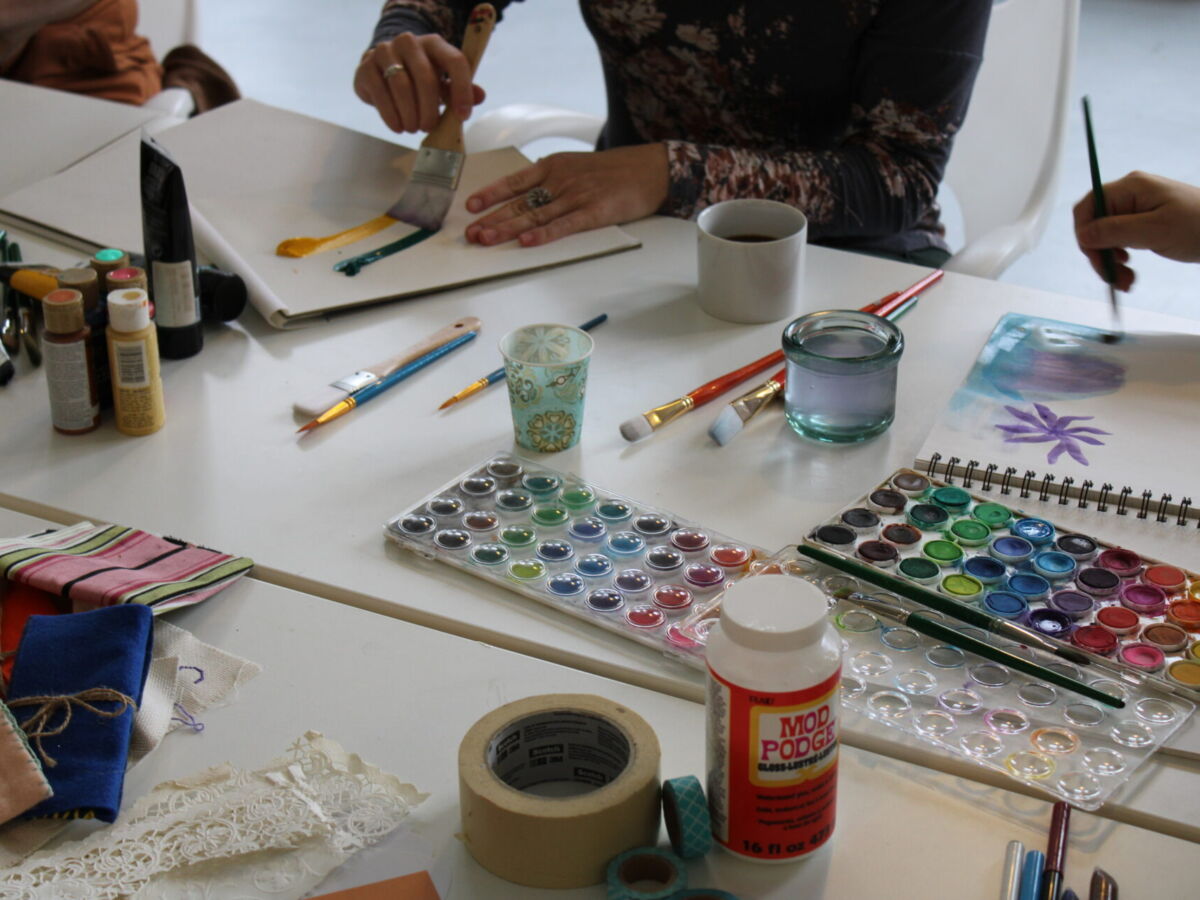Resource
Healing Trauma Through Expressive Art Activities
Expressive arts have long been recognized as profound means to healing.
We don’t need scientific proof of this (even though there is plenty). We feel this in our bones: after doodling, coloring, dancing, or even gardening, we feel a palpable difference in our mental state. If you’ve ever spoken to an artist, you know how powerful artmaking can be for recovery from trauma. It helps get feelings out of the body and onto a canvas, page, or stage. But, for those of us that don’t consider ourselves artists (or even creative!), expressive arts activities can still offer powerful healing benefits. They are also a particularly powerful tool for survivors. Because survivors might struggle to articulate their feelings due to the overwhelming nature of their trauma, or simply because they’re not ready to talk about it, traditional talk therapy isn’t always helpful or wanted. The expressive arts offer an alternative pathway for self expression, empowerment, and holistic healing in the aftermath of trauma, and anyone (yes, even you!) can do this at home.

What are expressive arts?
“Expressive arts” refers to the practice of using creativity to heal. This can be achieved through visual art, writing, drama, dance, movement, and more. There’s a common misconception that healing through art can only take place with an art therapist or in a clinical, therapeutic setting. In therapy we are often expected to name, explore, and actively process memories and feelings. If you’re not ready or interested in that, I have good news for you: drawing, dancing, or writing at home, without the company of a therapist, still has healing benefits.
How do expressive arts improve mental health recovery after trauma?
Creative Arts and the Neuroscience of Healing
We don’t think it’s necessary to understand the science behind something in order to feel its benefit, but wanted to provide a simplified explanation for those who are interested. Engaging in expressive arts, such as coloring, journaling, singing, and collaging, involves repetitive and creative motions that signal our brain to enter a healing mode. You might have heard the phrase “flow state” before - it’s when our brains fully engage us in an activity and we experience a sense of energized concentration and enjoyment. Expressive arts, without any prior experience or special supplies, put our brain into a flow state, and therefore have significant neurological benefits. When we’re in a flow state, several neural networks are activated, including those responsible for a relaxed, reflective state, focused attention, and a sense of pleasure. What does this have to do with trauma? When experiencing a flow state, the brain can safely process memories and past traumas, maintaining a safe emotional distance that prevents the reactivation of personal safety alarms. As we explore conscious or subconscious emotions through art, our brain remains aware that this reflection is separate from reality, allowing for a healing experience without the confusion or stress that direct confrontation might trigger.
The Benefits of Creative Arts for Survivors’ Personal Recovery
In addition to the healing power of the “flow state,” engaging in expressive arts activities can offer survivors a deeply comforting and empowering way to overcome the isolation and shame often fueled by stigma. The hurtful stereotypes and misconceptions surrounding sexual assault unfairly silence and blame on survivors, leading them to feel rejected and alone. This stigma can make survivors feel like their voices and experiences are not valued. In one of my favorite books, Your Brain On Art, by Susan Magsamen and Ivy Ross, they describe how art “specifically combat[s] stigma by increasing activity in the cognitive control network of the brain...thus lowering self-criticism, self-judgment, and inhibition. It both helps people to cope and recover while engaging those who see their art, who come away with greater understanding and empathy.”
Through creating art, survivors can start to shift away from the self-blame and negative feelings that come from stigma, finding new ways to understand and embrace their experiences. When they share their art, it opens doors to understanding and compassion from others, helping to build connections and break down the barriers of silence. This sharing not only helps survivors feel seen and heard but also encourages meaningful conversations that challenge and change the stigma. In this way, expressive arts become a powerful tool for healing and fostering a sense of community and support.
The Benefits of Creative Arts in Healing Groups
It is no secret that survivors of sexual violence suffer from isolation and loneliness. Sexual violence can so frequently prevent survivors from developing healthy and trusting relationships. That inability to connect with others can also damage self-esteem over time, and reinforce the false notion that we are unworthy of love. Unsurprisingly, social connectedness is a crucial marker for mental health, as strong social bonds provide emotional support and contribute to a sense of belonging and stability. Research consistently shows that individuals with robust social connections experience lower levels of stress and better overall mental well-being.
Working in a group setting where creative expression is encouraged (and maybe even collaborated on!) allows survivors to connect with others who have similar experiences, breaking down the walls of isolation that can come from feeling misunderstood or alone. The act of creating art together fosters a sense of community and shared understanding, providing survivors with a safe space to express their emotions and experiences without fear of judgment. This communal approach not only validates their feelings but also nurtures a sense of belonging and support. By engaging in creative activities within a group, survivors can build meaningful connections, find comfort in their shared journeys, and begin to heal from the emotional wounds that have kept them isolated.
At Awakenings, a Chicago-based nonprofit dedicated to helping survivors of sexual violence heal through art (and one that I am proud to represent), survivors have the opportunity to participate in a curriculum-based healing art cohort. The cohort takes place over 8-weeks and brings survivors together to collaborate on a group art installation through a series of workshops on things like papermaking, printmaking, collage, and visual journaling. This program was developed after direct and frequent feedback from their survivor community, who asked for more long-term opportunities to meet and collaborate with other survivors. The program, while still in its infancy, has garnered promising and transformational results. One participant shared “I, for the first time, truly and openly showed up in a way that represented who I am as a survivor. This is significant to me because I put this part of myself into art and hid it from most people over the last 5 years. I don’t want to hide this self anymore, at least not in the way that I have been doing. I hope to search for what this means for me as a survivor and an artist in the years to come.”

What are some expressive art project ideas for healing?
Artmaking’s true power lies in its ability to facilitate healing in a safe and gentle way, allowing survivors to process their trauma without the need for words. Embracing the creative process, regardless of the outcome, and especially with others, can lead to profound self-discovery, connection, and healing. Remember - focus on the process, not the product! It doesn’t need to be perfect. While I am a huge advocate of sitting down to create with no intention or agenda, I understand that some might prefer some instruction or inspiration to get the creative juices flowing.
Creative Art Activities for Mental Health
Gratitude Collage
- Materials: Magazines, scissors, glue, a blank sheet of paper or cardboard.
- Instructions: Cut out images and words from magazines that represent things you’re grateful for. Arrange and glue them onto your paper to create a collage. Reflect on each element as you add it.
Emotion Wheel Drawing
- Materials: Paper, colored pens or markers.
- Instructions: Draw a large circle and divide it into segments like a pie. Label each segment with different emotions (happy, sad, anxious, etc.). Use colors and doodles to represent how you’re feeling in each segment.
Mindfulness Mandalas
- Materials: Printable mandala designs, colored pencils or markers.
- Instructions: Color a mandala design slowly and deliberately. Focus on the colors and patterns. Use the activity as a way to center yourself and relax.
Creative art activities for trauma recovery
Memory Box Creation
- Materials: Small box, decorative materials (paint, stickers, etc.), small items representing positive memories.
- Instructions: Decorate the box with colors and symbols that feel healing to you. Place small items or notes inside that remind you of positive experiences or achievements.
Safe Place Visualization Art
- Materials: Paper, colored pencils, markers (or anything!)
- Instructions: Close your eyes and visualize a safe and peaceful place. Draw, paint, collage, or create this place as vividly as you can. Use the artwork as a mental retreat when you need comfort.
Healing Tree Drawing
- Materials: Paper, colored pencils or markers.
- Instructions: Draw a tree with deep roots and branches reaching upward. On the roots, write or draw symbols of past experiences or challenges. On the branches and leaves, draw or write symbols of strengths, support, or positive aspects of your recovery. This visual representation helps focus on growth and healing
Creative art activities for anxiety management
Zentangle Meditation
- Materials: Paper, pen or fine-tipped markers, or a Zentangle book.
- Instructions: Start by drawing a simple border around your paper. Inside the border, divide the space into random shapes or sections. In each section, create repetitive patterns or doodles, focusing on the rhythm of your hand as you draw. Allow your mind to be absorbed in the process, letting go of stress and anxiety. Spend at least 15 minutes on this activity, focusing on the soothing repetition of the patterns and the calm it brings.
Breathing Art Exercise
- Materials: Paper, colored markers or pens.
- Instructions: Draw a series of circles or waves. As you inhale deeply, trace one line or circle; as you exhale, trace another. Continue this to synchronize your breath with your drawing.
Calming Nature Scenery
- Materials: Paper, colored pencils, or markers.
- Instructions: Draw a peaceful nature scene, such as a beach, forest, or mountain view. Use colors and details that evoke a sense of calm and tranquility. Spend time adding details slowly and mindfully, focusing on the soothing aspects of your drawing to help reduce anxiety.

